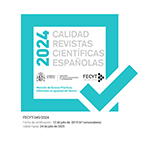Algunas reflexiones sobre los ordenamientos de moneda en Castilla (1296-1335). Beneficios y beneficiarios de su lectura interesada y del uso de información privilegiada
Resumen
Desde la segunda mitad del siglo XIII, las cecas europeas estuvieron inmersas en una creciente actividad. Estas instituciones, hasta entonces fugaces, se convirtieron en establecimiento permanentes. Sus operarios alcanzaron un elevado nivel profesional mientras los maestros aprendieron a leer entre líneas los ordenamientos de moneda para incrementar sus beneficios. Con la expresión francesa chatouiller le remède se hace referencia a la acuñación por las cecas de series de monedas ajustadas a los valores más débiles permitidos por la ley. En este trabajo exploramos la posibilidad del uso de esta técnica en Castilla durante el siglo XIV. Paralelamente comprobamos como los arrendadores de las cecas supieron relacionar la información de las nuevas emisiones monetarias con otras actividades mercantiles, puramente especulativas, que resultaron muy lucrativas para ellos y perniciosas para la economía.
Descargas
Descarga artículo
Licencia
La revista En la España Medieval, para fomentar el intercambio global del conocimiento, facilita el acceso sin restricciones a sus contenidos desde el momento de su publicación en la presente edición electrónica, y por eso es una revista de acceso abierto. Los originales publicados en esta revista son propiedad de la Universidad Complutense de Madrid y es obligatorio citar su procedencia en cualquier reproducción total o parcial. Todos los contenidos se distribuyen bajo una licencia de uso y distribución Creative Commons Reconocimiento 4.0 (CC BY 4.0). Esta circunstancia ha de hacerse constar expresamente de esta forma cuando sea necesario. Puede consultar la versión informativa y el texto legal de la licencia.
La revista En la España Medieval no cobra por tasas por envío de trabajos, ni tampoco cuotas por la publicación de sus artículos.












